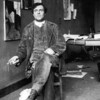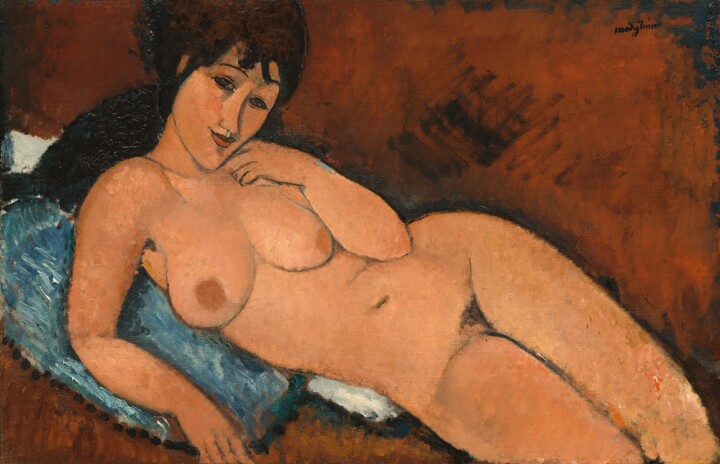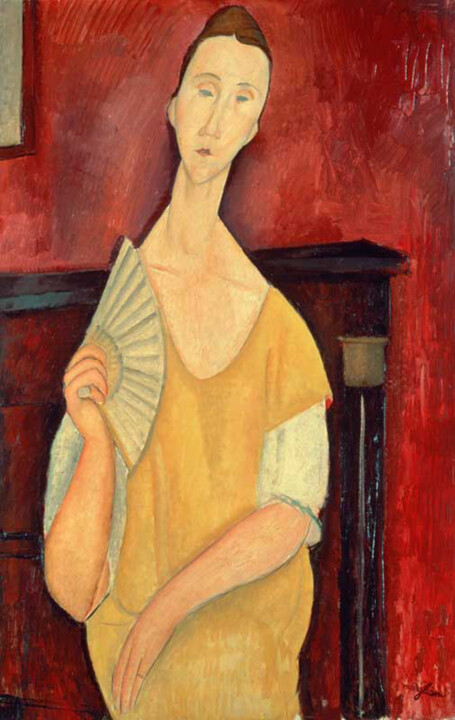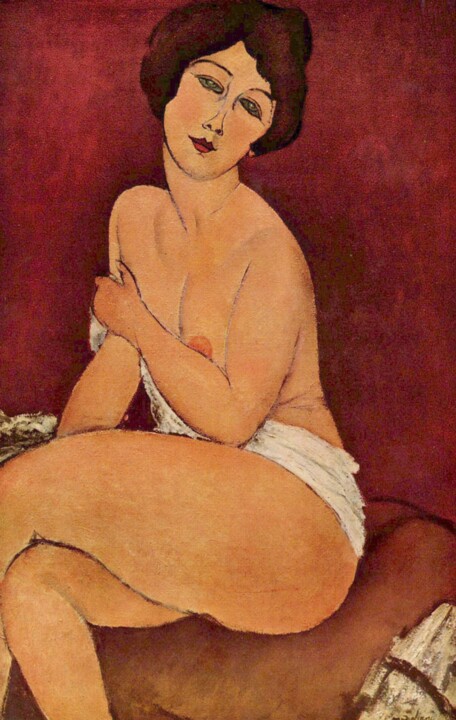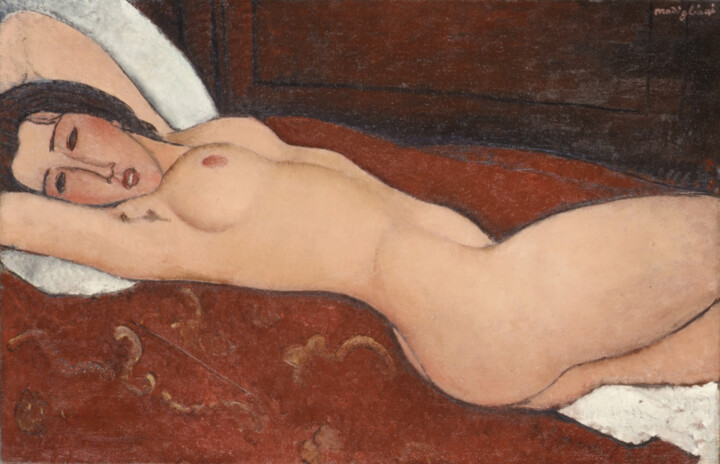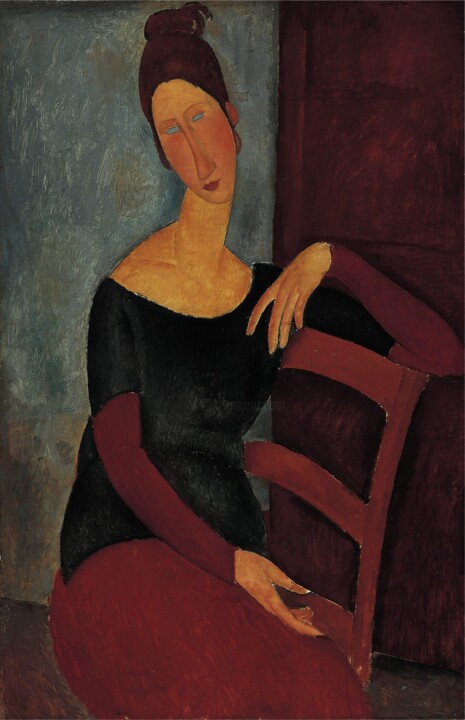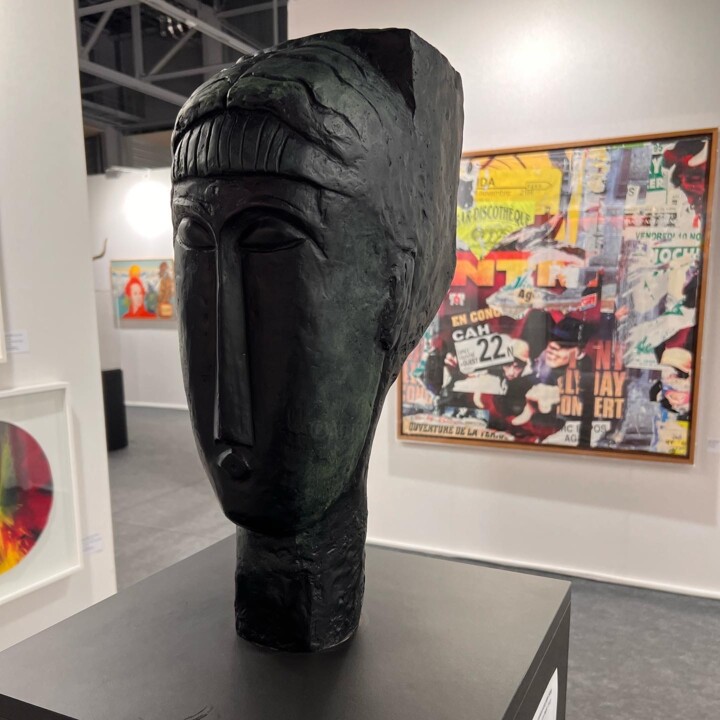
Who was Amedeo Modigliani?
Amedeo Clemente Modigliani was an Italian painter and sculptor who lived and worked from 1884 to 1920. He did most of his work in France. He is known for portraits and naked people in a modern style with faces, necks, and bodies that are stretched out. These works were not well received during his lifetime, but they became very popular after his death. Modigliani grew up in Italy, where he learned about ancient and Renaissance art. He moved to Paris in 1906, where he met artists such as Pablo Picasso and Constantin Brancuşi. By 1912, Modigliani was showing very stylized sculptures at the Salon d'Automne with the Cubists of the Section d'Or group.
His works include both paintings and drawings. Between 1909 and 1914, he mostly worked on sculpture. Portraits and full figures were the main things he painted and sculpted. Modigliani didn't have much success while he was alive, but after he died, he became very well-known. At the age of 35, he died in Paris of tuberculous meningitis.

Amedeo Modigliani, Reclining Nude, 1917. Oil on canvas, 60.6 x 92.7 cm. New York: MET.
Three key concepts regarding Modigliani:
- Modigliani changed the way people were depicted naked. His works in this genre stand out for their lack of modesty and mythological undertones, which were common in many earlier pictures of naked people. Because of these things, and because the artist was a known "play boy", Modigliani's nudes were considered scandalous when they were made.
- Modigliani's portraits show the personalities of the people he paints, and they all have the same long necks and almond-shaped eyes that are his "trademarks". Modigliani's portraits are also an important part of art history because they are a gallery of the most important people in the École de Paris circle, which he joined when he moved to Paris in 1906.
- The Romanian sculptor Constantin Brancusi's work may have had the biggest impact on Modigliani's creative growth. Even though Modigliani is best known as a painter, he spent much of his early career working on sculpture, and some writers have suggested that he may have seen sculpture as his true calling. The sculptures Modigliani made from 1909 to 1914 had a big impact on his work as a painter. They helped him develop his abstract and linear style.

Amedeo Modigliani, Lying nude, 1917-18. Oil on canvas. Private collection.
Before the well-known transfer: Leghorn, Florence and art education
Livorno: the home town
Modigliani was born in Livorno, Italy, to a family of Sephardic Jews. Livorno is a port city. For a long time, it was a safe place for people who were being persecuted because of their religion, and it had a large Jewish population. Solomon Garsin, his great-great-grandfather on his mother's side, was a refugee who moved to Livorno in the 1800s.
Eugénie Garsin, Modigliani's mother, was born and raised in Marseille. She came from a family with Sephardic roots that had lived along the Mediterranean coast for many generations. Her ancestors could speak many languages and were experts on sacred Jewish texts. They also started a school where Talmudic studies were taught. A family story said that the family tree went back to the Dutch philosopher Baruch Spinoza in the 17th century. Money lending was the family business, and they had branches in Livorno, Marseille, Tunis, and London. Their fortunes went up and down, though.
Flaminio Modigliani came from a family of successful businessmen and entrepreneurs who were Italian Jews. Even though they didn't know as much about other cultures as the Garsins, they knew how to invest in and build successful businesses. When the Garsin and Modigliani families told each other that their children were getting married, Flaminio was a young mining engineer with a lot of money. He was in charge of the mine in Sardinia and almost 30,000 acres of woods that belonged to his family.
In 1883, things went from good to bad for this wealthy family. When the price of metal went down, it put the Modiglianis out of business. Modigliani's mother was always looking for ways to make things work. She used her social connections to start a school, which she and her two sisters ran successfully.
Amedeo Modigliani was the fourth child, and he was born at the same time that his father's businesses went bankrupt. The birth of Amedeo saved the family from going bankrupt. An old law said that creditors couldn't take the bed of a woman who was pregnant or who had just given birth. The bailiffs came to the family's house right as Eugénie went into labor. To protect their most valuable belongings, the family piled them on top of her.
He was close to his mother, who taught him at home until he was 10 years old. After getting pleurisy when he was about 11, he had trouble with his health. A few years later, he got typhoid fever. When he was 16, he got sick again, and this time he got tuberculosis, which would kill him. After Modigliani got over his second bout of pleurisy, his mother took him on a tour of southern Italy. They went to Naples, Capri, Rome, and Amalfi, and then went north to Florence and Venice.
In many ways, it was because of his mother that he was able to make art his career. She wrote in her diary when he was 11 years old, "The child's personality is still so young that I can't say what I think of it." Even though he acts like a spoiled child, he is smart. We'll have to wait and see what's inside this chrysalis. Maybe a creative person?

Art education around Italy
Modigliani drew and painted from a very young age, and his mother wrote that he thought he was "already a painter" even before he went to art school. Even though his mother was worried that letting him study art would get in the way of his other studies, she gave in to the young Modigliani's passion for the subject.
When he was 14 and sick with typhoid fever, he went crazy and said he wanted to see the paintings in the Palazzo Pitti and the Uffizi in Florence more than anything else. Since Livorno's museum only had a few paintings by Italian Renaissance masters, he was fascinated by the stories he had heard about the great works in Florence. He was very sad that he might never get the chance to see them in person, though, because he was sick. When he got better, his mother said she would take him to Florence herself. Not only did she keep this promise, but she also promised to put him in touch with Guglielmo Micheli, the best painter in Livorno.
From 1898 to 1900, Modigliani worked at Micheli's Art School. Llewelyn Lloyd, Giulio Cesare Vinzio, Manlio Martinelli, Gino Romiti, Renato Natali, and Oscar Ghiglia would have worked with him in that studio. Here, he got his first formal art lessons in an area where the styles and themes of Italian art from the 19th century were studied. There are still signs of this and his studies of Renaissance art in his earliest works done in Paris. Parisian artists like Giovanni Boldini and Toulouse-Lautrec influenced his early work. Modigliani showed a lot of promise while studying with Micheli. He only stopped studying when he got tuberculosis and had to stop.
In 1901, when Modigliani was in Rome, he liked the dramatic religious and literary scenes painted by Domenico Morelli. The group of artists called "the Macchiaioli" (from macchia, meaning "splash of color" or, more offensively, "stain") were influenced by Morelli, and Modigliani had already been exposed to the ideas of the Macchiaioli. This small-scale landscape movement was a reaction to the bourgeois styles of the academic genre painters. Although they were similar to and even predated the French Impressionists, the Macchiaioli did not have the same effect on artistic culture around the world as Monet's contemporaries and followers.
His first art teacher, Guglielmo Micheli, was a member of the movement, so Modigliani was also. Micheli was not only a Macchiaiolo, but he also learned from one of the movement's founders, Giovanni Fattori. Micheli's work, on the other hand, was so popular and the genre so common that Modigliani, when he was young, rebelled against it. He chose to ignore the movement's obsession with landscapes, which was also a feature of French Impressionism. Micheli also tried to get his students to paint outside, but Modigliani never really liked it. He sketched in cafes, but he preferred to paint inside, especially in his own studio. Even when he had to paint landscapes (there are three known), Modigliani used a proto-Cubist color scheme that was more like Cézanne's than the Macchiaioli's.
Modigliani studied not only landscapes with Micheli, but also portraits, still life, and the naked body. His classmates remember that he was at his best in the last class. Even though Modigliani didn't like the Macchiaioli method, his teacher liked him and called him "Superman." This was because Modigliani was very good at art and often quoted from Nietzsche's book Thus Spoke Zarathustra. Fattori would often stop by the studio, and he liked the new ideas that the young artist was coming up with.
In 1902, Modigliani joined the Scuola Libera di Nudo, or "Free School of Nude Studies," at the Accademia di Belle Arti in Florence. This was the start of a lifelong love of drawing from life. A year later, he moved to Venice and signed up to study at the Regia Accademia ed Istituto di Belle Arti. He was still sick with tuberculosis at the time. In Venice, he tried hashish for the first time, and instead of studying, he began to hang out in bad parts of the city. It's hard to say how these choices affected his developing artistic style, but they seem to be more than just teenage rebellion or the hedonism and bohemianism that was almost expected of artists at the time. His interest in the seedier side of life seems to have come from his love of radical ideas, like Nietzsche's.
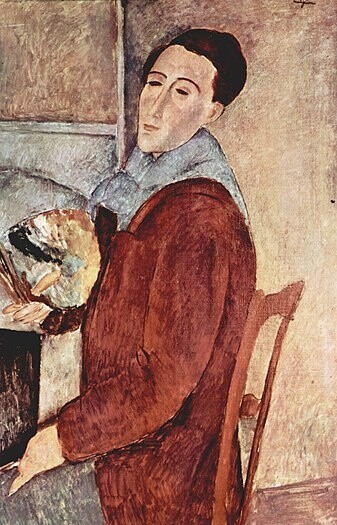
Amedeo Modigliani, Autoritratto, 1919. Oil on canvas, 100 x 65 cm. San paolo: Contemporary art Museum.
Modigliani arrives in Paris
In 1906, Modigliani moved to Paris, which was the center of avant-garde art at the time. In fact, he moved to the center of art experimentation at the same time as Gino Severini and Juan Gris, two other foreigners who would also leave their mark on the art world.
Later, he became friends with Jacob Epstein. The two of them wanted to open a studio together and make a Temple of Beauty that everyone could enjoy. Modigliani drew and painted the stone caryatids for "The Pillars of Tenderness" that would support the imagined temple.
In 1910, Modigliani moved into the Bateau-Lavoir, which was a community for poor artists in Montmartre. He rented a studio on Rue Caulaincourt. Even though most of the artists in this part of Montmartre were poor, Modigliani at least at first looked like the son of a family trying to keep up appearances of its former wealth. He dressed well without being flashy, and the studio he rented was decorated in a way that would suit someone with a refined taste for plush draperies and Renaissance reproductions. Soon, he tried to look like a bohemian artist, but even in his brown corduroys, red scarf, and big black hat, he still looked like he had fallen on hard times and was living on the street.
When he first moved to Paris, he wrote to his mother often, drew his naked bodies at the Académie Colarossi, and didn't drink too much wine. People who knew him at the time thought he was a little shy and almost antisocial. He is noted to have commented, upon meeting Picasso who, at the time, was wearing his trademark workmen's clothes, that even though the man was a genius, that did not excuse his uncouth appearance.

Life as a Bohemian
But in the year after he moved to Paris, his behavior and reputation changed in a big way. He went from being a well-dressed artist who went to school to being a kind of prince of drifters.
Louis Latourette, a poet and journalist, went to see the artist's studio after he had changed. He found the place in chaos, with the Renaissance reproductions off the walls and the plush drapes all over the place. By this time, Modigliani was already an alcoholic and a drug addict, and this was clear in his studio. Modigliani's actions at this time show how his style was changing as an artist. His studio had almost become a sacrifice for all the things he didn't like about the academic art that had shaped his life and training up to that point.
Not only did he get rid of everything that reminded him of his bourgeois background, but he also destroyed almost all of his early work, which he called "childish baubles" made when he was a "dirty bourgeois."
People have a lot of ideas about what made him turn so violently against his younger self. Modigliani created a fake persona for himself as soon as he got to Paris. He worked hard to get a reputation as a hopeless drunk and a heavy drug user. Modigliani may have used his increasing use of drugs and alcohol to hide the fact that he had tuberculosis from his friends, who didn't know about it. Tuberculosis was France's leading cause of death by 1900. It was easy to spread, there was no cure, and people with it were feared, shunned, and pitied. Modigliani was a social person who didn't want to be alone as a sick person. He used alcohol and drugs to ease his physical pain, which helped him keep up the appearance that he was healthy and allowed him to keep making art.
From about 1914 on, Modigliani drank and used drugs more and more. After years of going into remission and coming back, this was the time when his tuberculosis symptoms got worse, showing that the disease had reached a late stage.
He hung out with artists like Utrillo and Soutine because he wanted other artists to accept and praise his work. Even in this Bohemian environment, Modigliani stood out because he had many affairs, drank a lot, and used absinthe and hashish. When he was drunk, he would sometimes take his clothes off in public. He died in Paris, aged 35. He became the perfect example of a sad artist, and after he died, his story became almost as famous as that of Vincent van Gogh.
In the 1920s, after Modigliani's career took off and after André Salmon said that Modigliani's style came from his use of hashish and absinthe, many aspiring artists tried to copy his "success" by getting high and living a bohemian lifestyle. Salmon said that Modigliani was a very ordinary artist when he was sober, ""...from the day that he abandoned himself to certain forms of debauchery, an unexpected light came upon him, transforming his art. From that day on, he became one who must be counted among the masters of living art."
Some art historians think that Modigliani could have reached even higher artistic heights if he hadn't been so caught up in his own self-indulgences and let them destroy him.
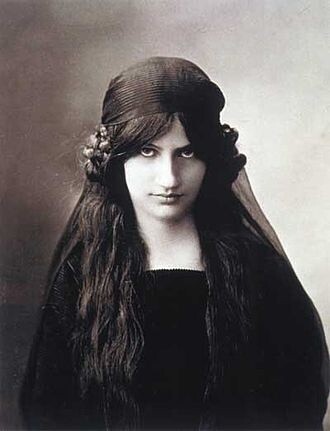
Meeting the love of his life
In the spring of 1917, he met a 19-year-old art student named Jeanne Hébuterne through the Russian sculptor Chana Orloff. Jeanne Hébuterne had posed for Tsuguharu Foujita. Hébuterne came from a strict, bourgeois family, and her devoutly Roman Catholic family disowned her because of her relationship with Modigliani, whom they saw as little more than a drunk and a scofflaw. Even though her family didn't like it, they soon moved in together.
After breaking up with the English poet and art critic Beatrice Hastings, Modigliani and Hébuterne moved into a studio together on the Rue de la Grande Chaumière. Jeanne started to pose for him, and she shows up in a few of his paintings. Jeanne Hébuterne became one of Modigliani's main art subjects.
Early in 1918, as the First World War was coming to an end, Modigliani and Hébuterne left Paris to get away from the war. They went to Nice and Cagnes-sur-Mer. They would live in France for a year. During that time, they had a lot of friends, including Pierre-Auguste Renoir, Pablo Picasso, Giorgio de Chirico, and André Derain.
On November 29, 1918, after he and Hébuterne moved to Nice, she gave birth to a daughter they named Jeanne (1918–1984). Modigliani already had a son with Simone Thiroux, Gérard Thiroux, who lived from 1917 to 2004. He also had at least two other children with other women. In May 1919, they moved to an apartment on the rue de la Grande Chaumière in Paris with their young daughter.
Hébuterne became pregnant again. Then Modigliani proposed to her, but Jeanne's parents were against it because Modigliani was known to be an alcoholic and drug user. But Modigliani made it official that her daughter was his. When Modigliani found out he had a severe form of tuberculosis, the wedding plans were ruined, even though Jeanne's parents were against it.
The most famous love suicide in art history
Even though he kept painting, Modigliani's health got worse quickly, and his blackouts from drinking got worse.In 1920, when he hadn't been heard from for a few days, a neighbor went to check on the family. He found Modigliani in bed, holding onto Hébuterne, and very drunk. Even though a doctor was called, there wasn't much that could be done for Modigliani because he was in the last stages of his disease, tuberculous meningitis. He died at the Hôpital de la Charité on January 24, 1920.
Many people from the art communities in Montmartre and Montparnasse went to the huge funeral. When Modigliani died, Hébuterne, who was 21 and expecting their second child, was eight months along. Hébuterne was taken to her parents' house the day after Modigliani died. There, she couldn't stop crying, so she threw herself out of a fifth-floor window, killing herself and the baby she was carrying.
The Père Lachaise Cemetery is where Modigliani was laid to rest. Hébuterne was buried at the Cimetière de Bagneux near Paris. Her angry family didn't let her body be moved to rest next to Modigliani until 1930. Both of their names are on a single tombstone. "Struck down by death at the moment of glory" is written on his tombstone. Hers says, "Loyal companion to the point of death."
Modigliani only had one solo show in his life, and he gave away his work in exchange for meals in restaurants. He died without any money.
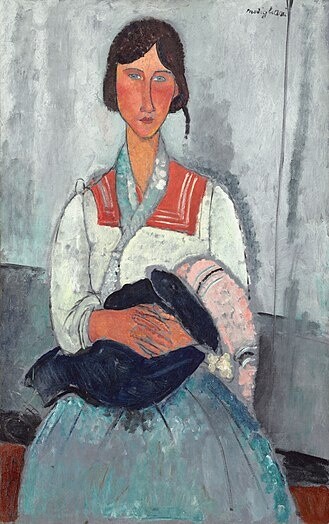
Amedeo Modigliani, Gypsy with child, 1919. Oil on canvas, 115.9 x 73 cm. Washington: National Gallery of Art.
What are the works of Amedeo Modigliani?
- Jeanne Hébuterne with hat, 1918, Pescara, Private collection.
- Portrait of Jeanne Hébuterne, 1918, Paris, Private collection.
- The Jewess,1908, Paris France, Private Collection.
- Amazon, 1909, Paris, Private collection.
- Red bust, 1913, Paris, Private collection.
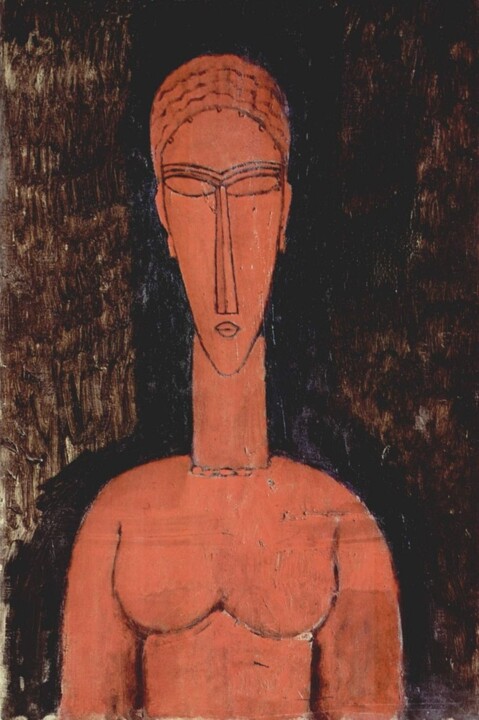
Oil on cardboard, 81×51 cm.
Red Bust is an oil painting on cardboard (81 x51 cm) made in 1913 by Italian painter Amedeo Modigliani. It is part of a private French collection. Modigliani was inspired by African art in making this work, a current that greatly influenced his Parisian production between 1905 and 1906.
- Standing Caryatid,1913, Paris, Private Collection.
- Portrait of Paul Alexanders, 1913, Saint-Lô, Museum of Fine Arts.
- Portrait of Diego Rivera,1914, Paris, Private Collection.
- Portrait of Burty Frank Haviland,1914, Paris, Private Collection.
- Portrait of Raymond,1915, Monte Carlo, Private Collection.
- Madame Pompadour, 1915, Chicago, Art Institute.
- Portrait of Celso Lagar, 1915, Oil on canvas, France, Musée d'Israel.
- L'enfant gras, 1915, Milan, Pinacoteca di Brera.
- Alice, 1915, Copenhagen Denmark, Statens Museum for Kunst.
- Portrait of Paul Guillaume,1915, Paris France, Musée de l'Orangerie.
- Portrait of Beatrice Hastings in front of a door, 1915, New York United States, Private collection.
- Portrait of Beatrice Hastings, 1915, Milan, Museo del Novecento.
- Seated Nude, 1916, London, Courtauld Gallery.

Oil on canvas, 92 x 62.
Seated Naked is an oil painting on canvas that was made by the Italian painter Amedeo Modigliani in 1916. It is 92 cm by 60 cm. The Courtauld Gallery in London is where it is kept. There is no way to know for sure, but Beatrice Hastings, who was with Modigliani at the time, may have been the model for the painting.
- Portrait of a Maid, 1916, London England, Courtauld Gallery.
- Portrait of Chaïm Soutine, 1916, Paris, Private Collection.

Oil on canvas, 100 × 65 cm.
Portrait of Cham Soutine is a 100 x 65 cm oil painting on canvas that Italian painter Amedeo Modigliani made in 1916. It belongs to a private collection in Paris. It is a portrait of Chaim Soutine, a Russian painter. As in many of Modigliani's works, there is a clear difference between the style of the subject's face and hands, which are refined and detailed, and the style of the background and dress, which are simple lines.
- Portrait of Chaïm Soutine near a table,1916, Washington United States, National Gallery of Art.
- Portrait of Monsieur Lepoutre, 1916, Paris, Private Collection.
- Portrait of Léopold Zborowski, 1916, Houston, Houston Museum of Fine Arts.
- Portrait of Léopold Zborowski, 1916, São Paulo Brazil, Museum of Art.
- Jacques Lipchitz and his wife Bertha, 1916, Chicago, Art Institute.
- Portrait of Jeanne Hébuterne, 1917, Philadelphia, Philadelphia Museum of Art.
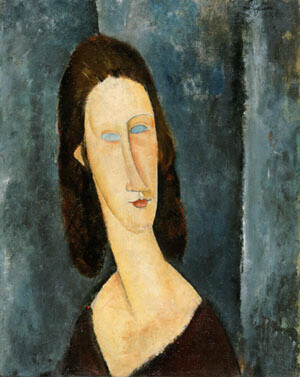
Oil on canvas, 54.6 × 42.9 cm.
The Italian painter Amedeo Modigliani made Blue Eyes (portrait of Madame Jeanne Hébuterne), which is an oil painting on canvas (54.6x42.9 cm) in 1917. The painting is owned by the Museum of Art in Philadelphia. Here, Modigliani paints Jeanne Hébuterne, who was his partner in his later years until he died and the subject of many of his paintings.
- Portrait of Elena Pavlowski, 1917, Washington, Phillips Collection.
- Girl in blue, 1917, Paris, Private collection.
- Girl with Blouse, 1917, Paris, Private Collection.
- Portrait of Léon Bakst, 1917, Washington, National Gallery of Art.
- Girl in yellow dress, 1917, Paris, Private collection.
- Seated boy with hat, 1918,
- Paris, Private collection.
- Portrait of Léopold Zborowski, 1918, Paris, Private Collection.

Oil on canvas, 46 x 27 cm.
Portrait of Léopold Zborowski is an oil painting on canvas that Amedeo Modigliani made in 1918. It is 46 x 27 cm. It belongs to a private collection in Paris. It is a picture of Modigliani's friend Léopold Zborowski, who was the subject of many paintings by the Italian artist. This painting shows Zborowski in a less formal way than others do, emphasizing his roles as a poet and scholar instead of an art dealer (as can be seen from the previous portrait of 1916). Modigliani could finish a painting in a few days, but he needed to see the subject in front of him at least in the beginning. He said, "To work, I need a living being, to see it in front of me." Then he could even finish it by himself.
- Two girls, Paris, Private collection.
- Girl with Hat, 1918, Paris, Private Collection.
- The peasant boy, 1918, London, Tate Gallery.
- Man sitting on orange background, 1918, Paris, Private Collection.
- The Beautiful Drogeristin, 1918, Paris, Private Collection.
- Seated Girl, 1918, Paris, Private Collection.
- Jeanne Hébuterne with hat, 1918, Japan, Japan Private Collection.
- Portrait of Jeanne Hébuterne in dark clothes, 1918, Paris, Private Collection.
- Portrait of Jeanne Hébuterne, 1918, Paris, Private Collection.
Modigliani's well-known quotes
- "When I know your soul, I will paint your eyes."
- "I myself am the instrument of the powerful forces that are born and die in me."
- "Your only duty is to save your dreams."
- "What I seek is neither reality nor unreality, but the unconscious, the mystery of instinct in the human race."
- "I want my life to be a fertile stream flowing joyfully through the earth."
- "Do not ask me who I am, nor demand that I remain unchanged."
- "To paint a woman is to possess her."

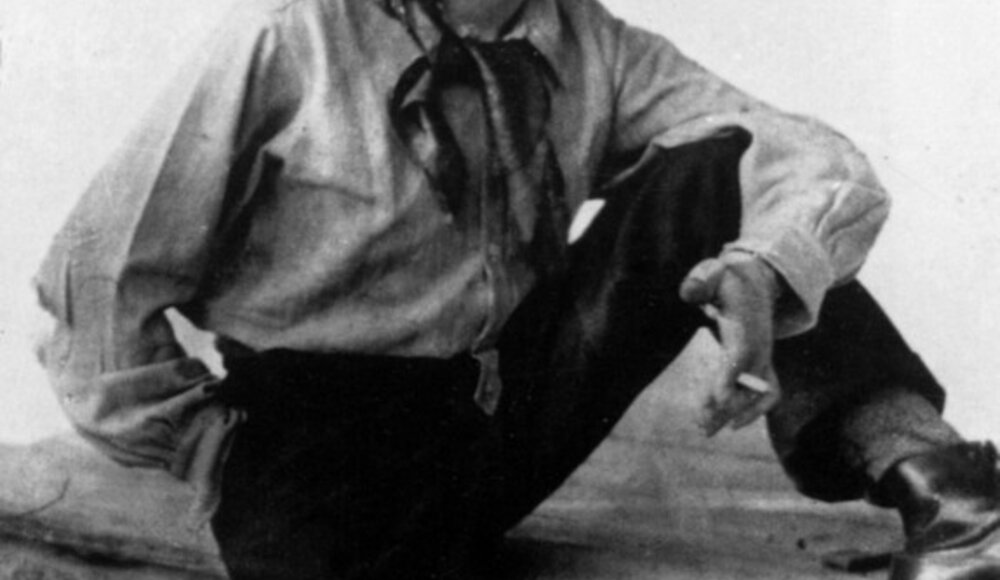
 Jean Dubreil
Jean Dubreil
